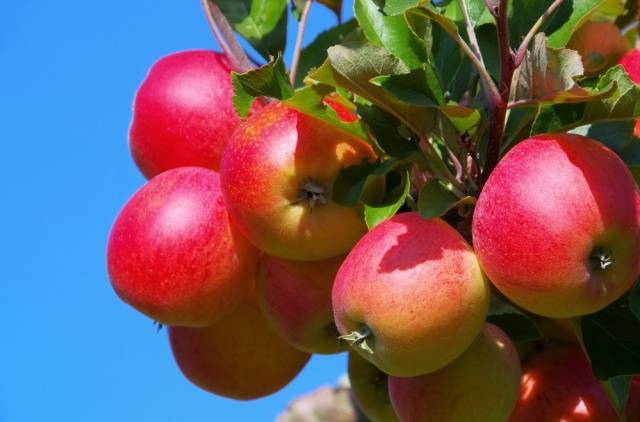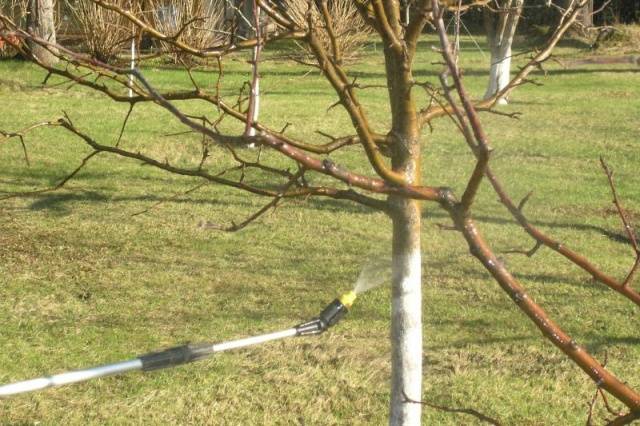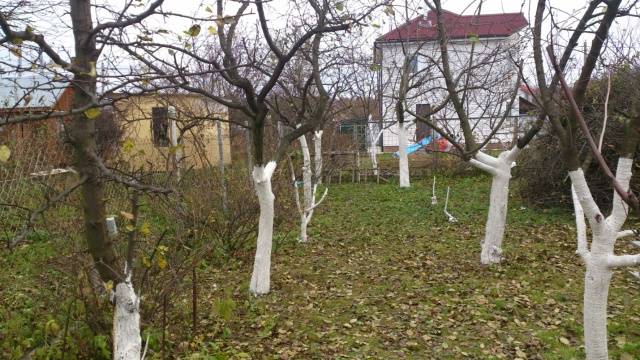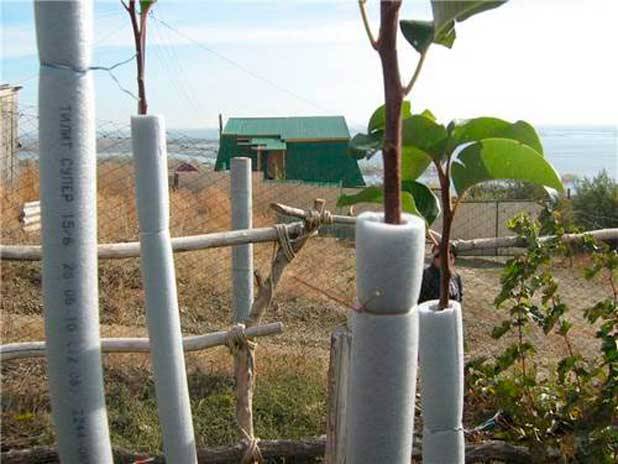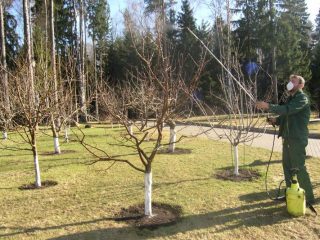Content
Here it is autumn... Experienced gardeners are rushing to complete the final preparations of trees and shrubs for frost. It is necessary to take care of apple trees during this period. Over the summer they devoted a lot of effort to the formation and growth of fruits. It is quite natural that caring for an apple tree in the fall is simply necessary so that next year it will also please you with a bountiful harvest. What work is important to do in the garden before frost sets in?
Do you need autumn care for apple trees?
Most gardeners prefer to transfer all work in the garden to the spring, believing that autumn care for apple trees is not so important. But this is a common mistake. Apple trees, like many other fruit trees, really need help to fully prepare for the cold.
Purpose of care activities apple trees in autumn is as follows:
- Protect trees from insects and pests;
- Carry out prevention against diseases;
- Protect from small rodents and hares;
- Protect apple bark from sunburn;
- Increase winter hardiness;
- Increase the quantity and quality of the future harvest.
As you can see, there is a lot of work in the garden in the fall, and without your help it will be difficult for apple trees to fully prepare for winter and survive severe frosts.
When to start preparing for winter. Deadlines for autumn work
Every summer resident has a lot of troubles in the fall. It is necessary to collect bountiful harvests, put fruits and vegetables into long-term storage, process the collected fruits, and in the garden there are just things that need to be done. A logical question arises: when should you start caring for apple trees in the fall and how to manage everything?
Autumn work in the garden is cyclical. By planning your time correctly, you can manage everything. It is important to complete the following activities before stable frosts:
- Clearing the garden of leaves;
- Autumn watering and fertilizing of apple trees;
- Loosening the soil under trees;
- Cleaning trunks and pruning;
- Disinfection;
- Whitewashing apple trees in autumn;
- Mulching;
- Protection of seedlings and trees from frost and rodents.
Separately, each stage does not take much time. You will learn from this article how to properly care for an apple tree and in what order to perform autumn work.
Clearing the garden of leaves
The first stage of caring for apple trees in the fall begins after harvesting with clearing the garden of fallen leaves and weed. Recently, it has been widely believed that remove leaves and grass not necessary. Supposedly it can serve as mulch for apple trees. But this is not so, leaving fallen leaves in the garden, you leave “home and shelter” to numerous insects and pests. Even ticks love to hide in garbage, leaves, and dry grass.
Therefore, in order to protect the apple trees, it is imperative to remove foliage from the garden.Do the same with weeds, broken branches and other debris that has accumulated over the summer. All collected garbage must be burned.
Autumn watering and fertilizing
After harvesting, you can immediately move on to the next stage of caring for apple trees. In the first and second ten days of September, fruit trees need to be watered abundantly. This is done so that the root system, which is sufficiently weakened by autumn, is saturated with moisture.
To save time and effort, you can combine autumn watering with timely fertilizing. Pour at least a bucket of water under each tree, and then apply fertilizer. Apple trees need to be fed twice in the fall - at the beginning and end of September. But they need to be watered at least 2-3 times a week.
When there is a lot of autumn rain, watering should be reduced to prevent the soil from becoming waterlogged.
Most of all, after abundant fruiting, apple trees need phosphorus and potassium in the fall. fertilizers. Apply fertilizer only in the amount indicated on the package. It is important to follow the order when caring for apple trees - first, abundant watering, and then fertilizing.
Fertilizing with fresh manure is strictly prohibited, as you can burn the roots.
At any stage of caring for apple trees, remember that how well you prepare your garden for the coming winter in the fall depends not only on its safety, but also on the quantity and quality of the harvest next year.
Loosening the soil
An important process in caring for apple trees is loosening the soil under the trees. This is necessary in order to enrich the soil with oxygen and ensure full access of fertilizers and moisture to the roots.After all, the root system will have to restore its balance in just a month and stock up on nutrients for the winter.
This activity should be carried out after the second feeding. You need to loosen the soil carefully, trying not to damage the roots. Forks are best suited for this purpose.
The day before loosening, water the apple trees generously. Carefully dig up the soil within a radius of 1-1.5 meters from the trunk with a pitchfork.
Autumn feeding and loosening is a kind of gratitude to your fruit trees for the tasty and aromatic fruits that they gave you in the fall.
Cleaning trunks and pruning
The next stage of sanitary work for caring for apple trees is autumn pruning of branches and cleaning of trunks.
You have to thoroughly clean the trunks of lichens, moss, growths, old, cracking bark, and also trim all unnecessary branches, treat open cuts and damaged areas.
Prepare the necessary tools and materials. To clean the trunks of apple trees you will need: a large piece of film or rags and a plastic spatula. Don't forget about personal protective measures: be sure to wear plastic goggles and cloth gloves.
If you installed “catching belts” in the garden, they must be removed, taken out of the garden and burned before starting work.
Before you start cleaning apple trees, you should make sure that the trunks are wet. It is advisable to clean them immediately after rain. But if autumn is stingy with precipitation, then the trunks need to be well moistened so that the bark becomes soft and pliable.
Spread an oilcloth around the apple tree.Using a plastic spatula, very carefully remove all excess: pieces of moss, lichen, old, cracked bark. This procedure is very important for trees. In this way, you block access for numerous insects and pests that like to settle in hard-to-reach places for the winter. And apple tree bark is an ideal place for them to winter and breed.
Now you can start pruning the apple trees.
Young apple trees undergo “light” pruning in the fall. That is, only damaged, dry and diseased branches are cut out. Gardeners also advise taking a closer look at how smoothly the young shoots grow. Severely curved ones should be ruthlessly cut out. In addition to sanitary treatment, you can shape the crown of young apple trees. Such pruning should be carried out during the annual autumn care of seedlings up to 4-5 years of age.
Mature apple trees undergo deeper pruning. In autumn, fruit trees need to be rejuvenated to increase yield. In addition to the defective branches, you need to cut out a third part of the crown. In addition, be sure to thin out the top of the apple trees so that each branch is sufficiently illuminated by the sun's rays.
Immediately after cleaning and pruning, all cleared debris and cut branches should be removed and burned immediately to prevent the spread of disease and spores.
Open cuts, cracks, and wounds must be treated immediately to prevent the possibility of infection. The following can be used as an antiseptic:
- Clay mash;
- Garden var;
- "RanNet" and other means for processing sections.
It is very important to complete these activities at least 3-4 weeks before the expected frost.It is best if you finish cleaning the trunks and pruning before the end of September, so that you have time to finish the rest of the work on caring for the apple trees in October. All cuts should dry out and last until the first frost.
Pruning apple trees in the fall is a very important step in garden care. Thanks to this event, the immunity of your fruit trees will increase, they will become more resistant to various diseases and pests.
Spraying trees
Beginning gardeners carry out disinfection measures mainly in the spring, bypassing the autumn treatment. But spraying apple trees in the fall is an equally important procedure.
Many insects and pests lay larvae and eggs under the bark of trees or in small cracks, or find reliable shelter there for the winter. To destroy insects and their numerous offspring, as well as to protect apple trees from possible infection with various diseases, spraying should not be postponed until spring.
Spraying can be carried out 5-7 days after pruning apple trees. Now that the harvest has been harvested and the sap flow in the apple trees has slowed down, you can safely use concentrated and enhanced preparations for disinfection.
Most often, apple trees are sprayed with urea or copper sulfate. The drugs must be diluted according to the instructions on the packaging. Immediately before starting work, do not forget about personal protection methods when working with chemicals.
Specialized stores offer a wide range of garden care products for processing and spraying fruit trees. But it's worth noting that many of them are highly toxic and can cause irreparable damage to your trees.Therefore, before purchasing, familiarize yourself with its composition and environmental impact.
Before spraying apple trees, be sure to check the weather forecast. On the day of treatment and the next 2-3 days there should be dry, windless weather so that all your work is not washed away by rain.
After treatment, at least 7-10 days must pass before the next stage can begin - whitewashing apple trees in the fall.
Autumn whitewashing
Contrary to popular belief, apple trees need to be bleached not only in spring, but also in autumn. The main function of autumn whitewash - not only destroy hordes of insects, but also protect fruit trees from sunburn, to which they are most often exposed in winter. The dark brown and black areas of the bark attract the sun's rays. And the bright, blinding reflection from the white snow causes lesions on the trunks.
Try not to skip this point when caring for apple trees in the fall, because the results will not appear immediately, but after a fairly long period of time.
At first, these small burned areas are almost invisible, but over time they become larger, causing irreversible processes: the yield gradually decreases, the tree becomes weaker and soon dies completely. To prevent this from happening, apple trees simply need to be whitened in the fall.
You can prepare the whitening composition yourself. Or you can use solutions for whitewashing trees, which are available in a wide range on store shelves.
Whatever composition you use, take note of a few tips:
- Apple trees should be whitened in dry weather in the fall. And it is desirable that the forecast be favorable for the next few days.
- Lime-based bleaching compounds are well suited for whitening adult apple trees. But when caring for young apple trees, it is better to use chalk-based whitewash solutions so as not to burn the young bark.
- When preparing a whitewash solution, keep in mind that the thicker its consistency, the better for the trees.
- Before whitewashing, select the right brush. Its width should be equal to the width of the trunk.
- When whitewashing apple trees, it is important to process not only the trunks, but also the skeletal branches to a height of 25-30 cm from the base.
- By adding “Creolin” or “Knockdown” to the whitening composition, you will protect apple trees from attacks by rodents and hares.
A few days after whitewashing, you can start mulching.
Mulching
Not every gardener pays due attention to this stage of caring for apple trees, believing that they will withstand winter frosts quite safely without it. But the fact is that mulching helps retain moisture and protects the trunks and root system from freezing. It is especially important to mulch young seedlings that are not even five years old.
Peat or spruce branches can be used as mulching material. It is undesirable to use when mulching:
- Mullein or fresh manure - they will burn the lower part of the trunk and roots.
- Leaves. Wet or rotten foliage is the best place for insects to overwinter and breed, as well as a likely source of infection.
- Hay or straw - they will become a haven for mice and other small rodents, which will not fail to settle in the mulch and significantly damage the bark and roots of trees.
The height of the mulch layer for mature trees should be at least 10-15 cm, for young apple trees - 20-25 cm.In northern regions, with regular temperature drops below - 35˚С - 40˚С, you can increase the mulch height to 30-35 cm.
Protection from frost and rodents
At this stage of caring for apple trees, it is important to provide proper protection from low temperatures in the fall, as well as take measures to prevent your trees from being attacked by hungry rodents and hares in winter.
Experienced gardeners use spruce branches or sawdust as an excellent insulation material. Pine and spruce branches can be laid around the trunk, or they can be tied so that they do not scatter when gusts of wind occur.
To protect against small rodents and hares, a chain-link mesh works well. You need to wrap it around the apple trees to a height of up to a meter, and fill the empty space with sawdust or spruce branches.
Many gardeners wrap young apple tree seedlings with rags or insulation to help them adapt to climatic conditions and protect them from freezing. The height of the wrap depends on the region. In the central regions, a height of 40-50 cm will be sufficient. But in the northern regions, it is advisable to wrap young apple trees to a height of at least a meter.
To learn how to care for an apple tree in the fall, watch the following video:
Conclusion
As you can see, in preparing fruit trees for winter nothing is difficult. It is important to follow the order of work on caring for apple trees and adhere to the approximate schedule of activities. The health and productivity of your apple orchard depends on how carefully and efficiently you approach this matter. The more attention and care you give to the apple trees, the more generously they will reward you with a bountiful harvest of fragrant, ripe apples.


